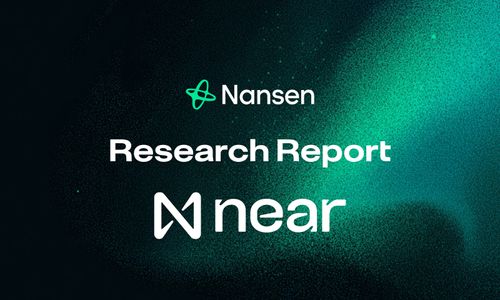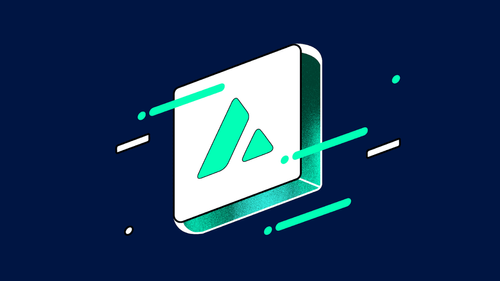Disclaimer: Nansen has produced the following report as part of its existing contract for services provided to Algorand Foundation (the "Customer") at the time of publication. While the Algorand Foundation has the right to review and provide feedback to Nansen, Nansen maintains full editorial control over the publication of this report. All views expressed are the independent opinions of Nansen's research analyst(s), who are the author(s) named in this report. This report is intended for informational purposes only and does not serve as investment, financial, professional, or other advice. For more information, please refer to the disclaimer at the end of this report and our Terms of Service.
Overview
Algorand is a blockchain designed to overcome the common trade-offs between scalability, security, and decentralization. Its Pure Proof of Stake (PPoS) consensus mechanism ensures fast, secure, and efficient transactions with instant finality, making it highly reliable for decentralized applications. Unlike many blockchains, Algorand is fully decentralized and permissionless, enabling anyone to participate in consensus while maintaining low transaction fees and high throughput.
Key developments in H1 2024 included the launch of advanced developer tools like AlgoKit v2, which improved the development experience, and partnerships that expanded the ecosystem's reach, including a collaboration with Coinbase. The platform also went live with its Dynamic Lamda upgrade, reducing block times by roughly 20%. Algorand continued to support innovation through governance rewards, investments in DeFi projects, and the integration of decentralized authentication tools like LiquidAuth. These initiatives reflect Algorand's commitment to building a secure, scalable, and user-friendly blockchain ecosystem.
Key Developments: H1 2024
- AlgoKit v2 launched on March 27th 2024. AlgoKit v2 enhances the development and deployment experience for developers building on Algorand. This version introduces comprehensive support for the end-to-end smart contract and dApp development lifecycle. Key features include native support for Python opening up the SDK for 10M+ Python developers worldwide. The platform now includes frontend templates to ensure modularity and maintainability, allowing developers to mix and match different smart contracts and frontend templates seamlessly. Additionally, end-to-end starter repositories have been established to bootstrap dApp projects efficiently, providing clear processes for linking frontend and backend templates and supporting manual and continuous deployment pipelines.
- The Algorand Foundation announced new partnerships that expanded its ecosystem reach. Through collaboration with Coinbase, deposit and withdrawal support for USDC was enabled, providing users with greater flexibility and ease of access to digital assets on Algorand. In addition, partnerships with AlchemyPay and Coinstore integrated more fiat on/off-ramp services, enhancing Algorand's appeal to users needing smooth transitions between crypto and traditional financial systems.
- Algorand v3.21 upgrade went live, introducing Dynamic Round Times and AVM v10, enhancing the platform's functionality and performance. Dynamic Round Times allows the blockchain to adjust block times based on network conditions, improving efficiency during high or low traffic periods. AVM v10 includes new opcodes, support for larger integer types, improved error handling, and additional cryptographic functions, providing developers with more tools for building sophisticated applications. These advancements ensure scalability, efficiency, and developer-friendly features on Algorand's blockchain infrastructure. This upgrade also decreased the average round time from 3.4 to 2.8 seconds.
- In June 2024, the Algorand Foundation introduced LiquidAuth, an open-source, decentralized solution for authentication and communication between wallets and dApps, addressing a critical security flaw: centralized wallet communication. By eliminating reliance on centralized providers like WalletConnect, LiquidAuth improves security through open standards like FIDO2/Passkeys, offering secure, chain-agnostic authentication without storing user data.
- The Foundation embraced Pera's enhanced explorer, which brings advanced features like transaction details, live updates, and NFT portfolio tracking, offering a more seamless and user-friendly experience. Pera's innovative updates ensure users can easily navigate and manage their portfolios while supporting the community's growing need for network transparency.
- Algorand Foundation's CTO office advanced its cost-reduction strategy by evolving the Algorand Relay Program and providing the option for non-archival relay nodes, significantly lowering storage requirements and therefore, operational costs. By handling these services internally, the Foundation reduced costs by over 50% while preparing for the introduction of a peer-to-peer network topology.
- Algorand partnered with the Government of Plateau State in Nigeria to explore blockchain applications in various sectors. The goal is to drive adoption and create use cases in areas such as education, healthcare, and governance. This partnership highlights Algorand's commitment to real-world blockchain applications that can drive public-sector innovation in emerging markets.
Ecosystem
DeFi
- The Foundation distributed 31.173M Algo as governance and DeFi rewards for Governance Period 9 (GP9), incentivizing community participation and ecosystem growth. This further strengthens Algorand's governance structure and aligns community interests. The introduction of governance rewards has been critical in driving sustained engagement and rewarding users for their long-term commitment to the platform.
- In Governance Period 10 (GP10), the Algorand community voted to allocate 7.5M Algo for DeFi rewards and 650K Algo for NFT rewards, supporting key projects and driving engagement across decentralized finance and NFT ecosystems.
- Algorand Ventures invested 2.507M Algo and $30K USD in various sectors including Impact, Access & Infrastructure, DeFi, and Web3, supporting projects like Vestige, Messina, and Defly Wallet. These investments are strategically aimed at fostering innovation and adoption within the ecosystem. Each investment is part of a broader strategy to increase on-chain activity, grow the user base, and improve ecosystem health through cutting-edge tools and services.
- In H1, DeFi ecosystem in Algorand continued to innovate and grow:
- Folks Finance, the top lending platform, reached $220M TVL! Tinyman, the leading DEX on Algorand, launched the TINY token and Tinyman Governance, with over 2,000 dedicated governors and growing.
- CompX, with its wide ranging DeFi offerings, continues to see its TVL grow, and launch innovative products, including Algogator portfolio tracking, the xUSD CDP, Token Streams, and X-NFT.
- Vestige Labs launched Rug. Ninja is a token launchpad where tokens can be instantly traded without large slippage. Liquidity is locked forever once a price threshold is reached.
NFTs & Gaming
- Algorand partnered with EXA Market to promote the NFT ecosystem and celebrate the launch of EXA Market v2. This event helped position Algorand as a leader in the NFT space. By collaborating with EXA, Algorand demonstrated its commitment to fostering innovation in NFTs, particularly in Europe, where the event is a major focal point for the NFT community.
- The Algorand Foundation funded the creation of 10 unique NFTs for a Decipher-themed artwork collection for their annual Decipher conference. This initiative was part of a broader effort to celebrate the creativity within the Algorand community, using 50,000 Algo from the Algorand NFT collections fund to commission these pieces. The artworks were featured at Decipher, and the aim was to further engage the NFT community while showcasing Algorand’s capabilities in supporting digital art and collectibles.
Enterprise
- The Algorand Startup Lab launched in India in partnership with T-Hub, supporting the growth of startups across sectors like healthcare and supply chain. This initiative welcomed 20 startups, boosting innovation and blockchain applications in emerging industries. The program saw over 100 applicants, reflecting strong interest from the Indian tech community, and is expected to drive blockchain solutions for real-world problems in various sectors.
- The Crust Network integration went live in January, enabling Algorand developers to access decentralized storage solutions like Crust Files and Crust Cloud. This integration provides a more robust infrastructure for dApps in the Algorand ecosystem. The collaboration enhances the scalability and security of applications, allowing them to store and retrieve data in a decentralized manner, a key feature for many Web3 solutions.
- The Algorand Blockchain Academy launched its beta version in partnership with the United Nations Development Programme, offering educational content and real-world blockchain use cases to participants. The program featured speakers from prominent projects like Wholechain and ClimateTrade.
- Algorand made substantial technical strides in H1 by releasing several new developer tools. The Live On-chain Resource Analyzer (Lora) was introduced to help developers better visualize and debug on-chain transactions, streamlining the development process. Additionally, new Python unit testing capabilities and updated APIs for Algorand Box Storage were made available, significantly improving the ease of developing and managing decentralized applications on Algorand.
- In April 2024, Algorand Foundation became a technical partner for the Frontech Accelerator, launched by CDP Venture Capital’s National Accelerator Network. The accelerator focuses on frontier technologies like digital identity, gaming, and AI, offering startups a six-month program and €120,000 investment. Algorand will mentor and guide participating startups, helping drive innovation in digital transformation.
- The Algorand Foundation has launched the Humanitarian Payments Council, a coalition with key partners such as Circle, Worldpay, Mercy Corps, UNDP, and HesabPay. This Council aims to revolutionize humanitarian aid delivery by leveraging blockchain technology to create secure, transparent, and traceable payment solutions for distressed regions. The Council will guide UN agencies and NGOs on implementing blockchain for aid payments and develop a roadmap for deploying blockchain-based cash programs in crisis areas.
On-chain Data
Daily Transactions

In H1 2024, the Algorand network kicked off the new year with a record-breaking 44 million transactions in a single day, primarily driven by the Orange (ORA) meme project. ORA is a mineable Algorand Standard Asset (ASA) that uses a fee-based mining system, where users compete by submitting transactions and paying fees, similar to Bitcoin's decentralized mining mechanism. The highest contributor in a given period is rewarded with ORA tokens. Daily transactions tapered off as the year continued before spiking to highs of 27 million and 20 million daily transactions to close out H1.
Daily Active Addresses

With the success of the ORA project at the start of 2024, users flocked to the platform, driving active addresses to an impressive 380,000 in a single day—a 158% increase from the 2023 peak. After this initial surge, the network saw several more spikes in activity, though it primarily stabilized within a range of 25,000 to 60,000 daily active addresses.
Top Entities by Users and Transactions
Nansen's list of labels provides a detailed overview of top entity interactions on Algorand, showcasing insights into user and transaction activity. USDC leads the stablecoin sector, boasting over 800,000 unique users, 87% higher than Tether, and 12.7 million transactions. Hypercube emerged as the top infrastructure protocol by users, surpassing Planets with over 500,000 users; however, Planets drove over 4,800% more transactions than Hypercube. ORA leads the entire network with the highest transaction volume, recording 432 million transactions, significantly outpacing the second and third-highest protocols, C3[C3.io] and World Chess, which processed 252 million and 57 million transactions, respectively.
Daily Contract Deployments

In H1 2024, Algorand saw a significant increase in daily contract deployment activity, with averages rising from 45,000 to over 80,000 contracts deployed daily. This growth indicates strong participation from dApp developers and the broader developer community.
Closing Thoughts
In the first half of 2024, Algorand showcased remarkable resilience and growth, further strengthening its position in the blockchain landscape. The network's record-breaking transaction volumes, increased active addresses, and new technological advancements proved Algorand's ability to scale while maintaining efficiency and security. Key developments, such as the launch of AlgoKit v2 allowing 10M Python developers worldwide to harness the SDK, LiquidAuth, and collaborations with global entities such as Coinbase, highlight its commitment to innovation. With growing participation in DeFi, NFTs, and enterprise initiatives, Algorand is well-poised to continue expanding its ecosystem. As blockchain adoption accelerates, Algorand is uniquely positioned to provide a secure, scalable, and decentralized infrastructure to meet the demands of the future.





